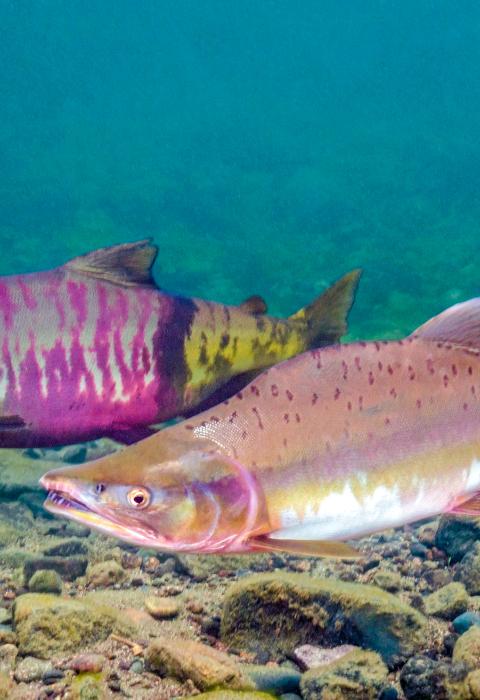Salmon River
Alaska
The Salmon River flows 70 miles from the limestone cirques of the highest peak in Kobuk Valley National Park, Mt. Angayukaqsraq, to the Kobuk River. The Salmon River supports an excellent grayling fishery and large runs of chum and pink salmon; the river owes its name to the large salmon runs. Over its course, the Salmon River flows through the ecotone where arctic tundra transitions into boreal forest lowlands. In the mountainous headwaters, the river rushes and tumbles through a narrow, steep-sided valley, often with bare rock walls on either side. In the middle reach, the river slows and forms numerous inter-connected deep pools as it flows through rolling hills. Water of exceptional clarity, coupled with blue-green gravel found in the area, give the pools exceptional color. In the lowlands, the water slows, flowing through low-growing spruce forests and treeless bogs until joining the Kobuk River.
Designated Reach
December 2, 1980. The segment within the Kobuk Valley National Park.
Outstandingly Remarkable Values
Culture
Human settlement at the mouth of the Salmon River has been traced back over 10,000 years. While only three archeological sites have been documented to date, all three are eligible for the National Register of Historic Places. The river corridor holds tremendous potential for archeological and paleontological resources based on other limestone cave formations found in the area and Onion Portage, which is a national historic landmark about 30 miles upstream from the mouth of the Salmon River.
Recreation
The Salmon River provides superlative opportunities for primitive and unconfined recreation. Visitors are almost guaranteed solitude and a pristine soundscape free from the impacts of human activity. Visitors will have an especially challenging experience in the wilderness. Many boaters with packrafts will usually have to hike in from outside the watershed to begin this Class I float trip. An adventure on the river requires advanced skills in self-reliance, backpacking, provisioning, and orienteering.
There are healthy populations of sportfish, such as chum salmon, Arctic char, and grayling. The water is crystal clear with deep green pools and many unnamed tributaries; exposed cliffs and bedrock add to the visual diversity.
Photographers and naturalists will enjoy a continuous range of scenery, from alpine tundra to low wetlands with a variety of wildlife. Wildlife viewing can be exceptional, with species such as caribou, moose, brown and black bear, and wolves present. Eagles and peregrine falcons nest in large trees and cliffs. The visiting season is a short three months, and in August the tundra and forest vegetation is spectacular with colors of red and gold.
Wildlife
The Salmon River is a quintessential example of the intact ecosystem processes of the northwestern Arctic and is inhabited by a representative suite of species. The river was designated as wild and scenic, in part, because of its use by the Western Arctic Caribou Herd during its spring and fall migration, moose in winter, and waterfowl during nesting. The river drainage supports unaltered habitat for predators, raptors, and fish, and unaltered predator-prey dynamics.

